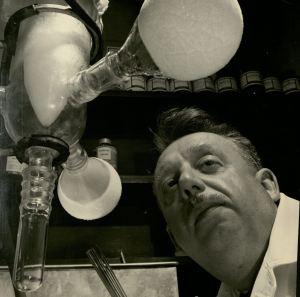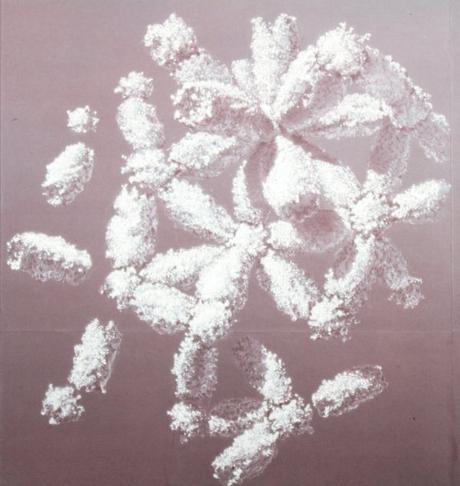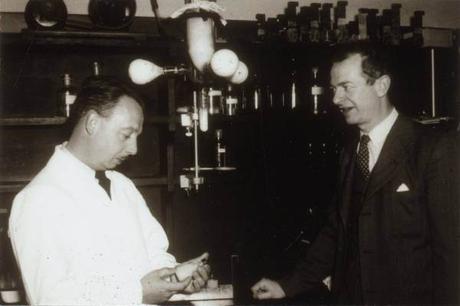
Dan Campbell, ca. 1940s.
[Part 1 of 2]
As a scientist, Linus Pauling is remembered by many for combining his expertise in chemistry with other fields. Often times Pauling would start off thinking about a problem from a chemical perspective and end up learning about a field entirely new to him, like cellular biology or medicine. Though this sort of cross-disciplinary work is more commonplace today (partly because of the example that Pauling provided), in the 1930s it was fairly rare for scientists to combine different fields of study. This given, pioneers of the cross-disciplinary approach often found it difficult to identify like-minded researchers with whom to collaborate. Fortunately for Pauling, a man with a very wide network, other researchers often found him.
After delivering a talk about hemoglobin in 1936, Pauling was pleasantly surprised to be consulted by Austrian medical researcher Karl Landsteiner. For many years, Landsteiner had been trying to understand how antibodies in the immune system work, and he believed that Pauling’s knowledge of medicine and chemistry could help him in his investigations. An antibody is a disease-fighting macromolecule that targets and rids the body of unwanted foreign substances, such as viruses and incompatible blood types. Landsteiner wanted to know how antibodies can target specific foreign substances with such precision. This encounter drew Pauling’s attention to the field of immunology, which would eventually become an important part of his research and would remain so for many years to come.
Pauling’s communications with Landsteiner spurred an interest in looking into the chemistry of antibodies and their substrates, antigens. At the time, however, most of Pauling’s focus was necessarily occupied with finishing up his previous program of grant-funded research on protein structures. Furthermore, Pauling was not an immunologist and the demands on his time were such that he could do little more than keep immunology in the back of his mind.
It wasn’t until 1939 that Landsteiner once again brought Pauling’s full attention back to antigens when he used Pauling’s theory of protein structure in a discussion about antibodies. Reading Landsteiner’s article sparked several ideas for Pauling which quickly led to his drafting a rudimentary theory of antibody chemistry. Six months later he found the perfect opportunity to test some these ideas.

Image extracted from a glass plate display, “Pictures of Antibodies,” prepared for the First International Poliomyelitis Conference, New York, 1948. The caption accompanying this image reads: “…[An] antibody-antigen framework which may precipitate from a solution or be taken up by phagocytic cells.”
Due to his unfamiliarity with the institution, by the time of his arrival in Pasadena Campbell had still not yet identified a research project on which to collaborate. Pauling advised Campbell to consider different researchers before making his final decision on where and with whom he might work. In the end, after asking around, Campbell chose to collaborate with Pauling on his theory of immunology.
This was a fortuitous decision, for several reasons. First, in addition to immunology, Campbell had a background in biophysics and chemistry, which made him a perfect candidate to test and develop Pauling’s antigen theory. More importantly, as Campbell began his initial investigations, it became apparent that Pauling’s ideas were flawed and that Pauling’s knowledge of chemistry alone would not be sufficient to make further progress in immunological research.

Campbell and Pauling, 1943.
Pauling had alleged that antibodies were similar to denatured proteins; that is, a protein that has lost its secondary and tertiary structures and has unfolded into an amino acid chain. Pauling’s theory anticipated that antibodies were an unfinished protein that required specific antigens in order to fold into the proper secondary and tertiary structures.
According to this model, antibodies would only form hydrogen bonds and thus would coil around chemically complementary antigens. As such, the theory explained how antibodies are able to bind unambiguously to their complementary molecules. However, Campbell’s results did not support all of Pauling’s ideas. Though his research showed that antibodies were in fact proteins, their physical structure before and after binding to antigens remained unclear.
Pauling’s lack of evidence for his theory of antibody structure and composition limited him to publishing only a single theoretical paper in which he explained his ideas about antibodies. In July 1940 the Journal of the American Chemical Society featured Pauling’s “A Theory of the Structure and Process of Formation of Antibodies.” The article received much attention and, despite the lack of evidence, was widely acclaimed, though it failed to provide a definitive explanation for antibody structure.
After the publication of the piece, Campbell once again tested Pauling’s theory, and this time his results were much more confusing, to say the least. Initially, it appeared that Campbell had succeeded in creating artificial antibodies by simply denaturing beef globulins (a protein found in blood) and later allowing them to refold around an antigen.
Word of these results greatly excited Pauling, who began to envision the mass production of antibodies using Campbell’s method. Reality turned out to be not so simple; when students and postdoctoral fellows tried to replicate Campbell’s experiment, they were unable to obtain the same results. Looking back now, it seems most likely that Campbell’s research assistants had misinterpreted the results of his experiment.
Pauling knew that he would need more time with Campbell to refine his theory, but that could only happen if Campbell’s position at Caltech was secured. In 1942 Pauling arranged for the Institute to offer Campbell an assistant professorship, which he accepted. By 1950 Campbell had become a full professor.
Combining immunology and chemistry proved to be a commendable approach for tackling many health concerns of the time. Likewise, Campbell’s presence was crucial to the development of Caltech’s immunochemistry department, which over a span of five years grew from a single office (Campbell’s) to a space occupying most of the third floor of Caltech’s Church Laboratory. Students and professors alike flocked to the growing department to discuss questions and engage in research on immunology, using chemistry as the basis of their approach. From the outset, both Pauling and Campbell benefited from one another’s expertise while colleagues at Caltech, and their partnership would continue to yield fruit for many years.
